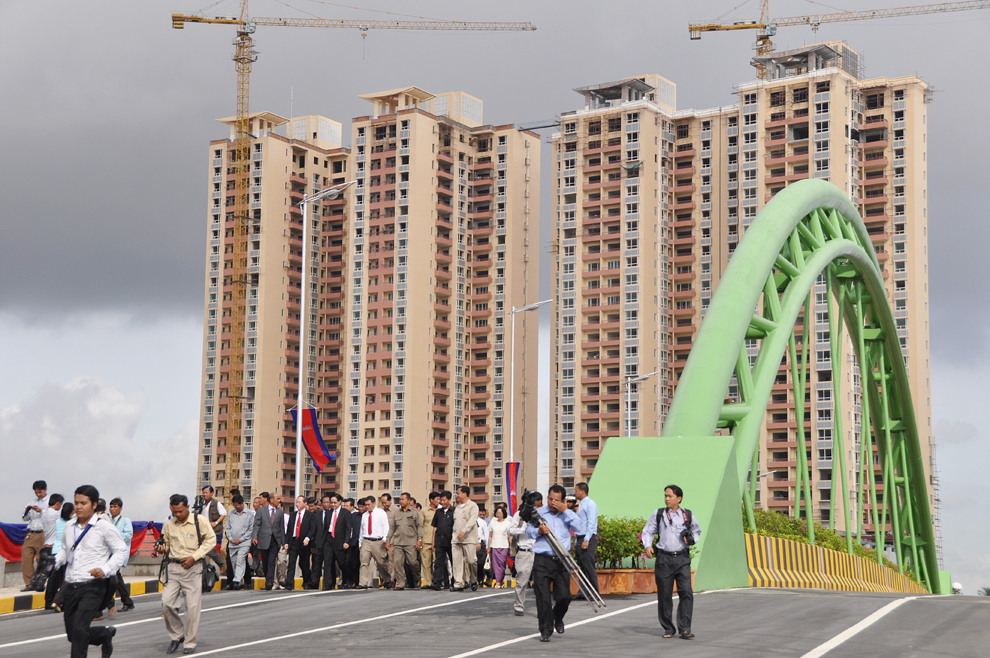
The Rose City Condominiums in the capital’s Chamkarmon district in 2011. Construction on the four towers finished last year. Meng Kimlong
A Mid global economic fragility, foreign direct investment (FDI) in Cambodia grew a whopping 73 per cent in 2012 from the year before, a huge increase helping to fuel a record-setting amount of money pouring into least developed countries, according to the United Nations Conference on Trade and Development.
Released at the end of last week, the UN group’s World Investment Report says that FDI in Cambodia reached almost $1.6 billion in 2012, compared with $902 million in 2011, an increase largely credited to businesses looking to invest in the inexpensive, labour-intensive garment and manufacturing industries, as well as rising production costs outside of Cambodia.
Regionally, Southeast Asia saw a two per cent rise in FDI inflows, reaching $111 billion. And for the first time, the report noted that developing economies absorbed more FDI – accounting for 52 per cent globally – than developed nations.
Cambodia, the Democratic Republic of the Congo, Liberia, Mauritania, Mozambique and Uganda drove much of the growth that amounted to a global FDI in least developed nations of $26 billion, according to the UN tally.
“[Countries such as Cambodia, Myanmar and Vietnam] are the emerging bright spots of the subregion, particularly for labour-intensive FDI and value chain activities,” the report said.
According to the UN, foreign direct investment in Myanmar totaled $2,2 billion in 2012, a 1.96 per cent increase compared to 2011. Vietnam FDI reached $8,4 billion last year, a 12.6 per cent increase compared to the previous year.
The UN refers to FDI as “an investment made to acquire lasting interest in enterprises operating outside of the economy of the investor”.
Chan Sophal, president of the Cambodian Economic Association, said yesterday that FDI sources, other than the garment industry and manufacturing, include agriculture and tourism.
“If the increase is true . . . I think it’s due to the good potential for investment in Cambodia,” he said. “In manufacturing, electronics, agriculture, tourism, in every sector, there are many opportunities for investment.”
It doesn’t take long to find the projects. Last December saw the ground-breaking ceremony of the Aeon Mall in Phnom Penh. The 68,000 square metre building worth $205 million is being built by Japan-based AEON Group.
Japan, alongside China and South Korea, is one of the top investors in Cambodia.
The UN report, subtitled Global Value Chains: Investment and Trade for Development, also said countries are increasingly considering “how to position and promote themselves” as locations for global value chain activities, “either in a segment or part of the chain or the entire chain”.
Against the background of Delta Electronics (Thailand)’s plans to expand to Cambodia, Asian Development Bank Deputy Country Director Peter Brimble told the Post in May that firms expanding operations in Cambodia are the same firms that moved to Thailand some 20 to 25 years ago and are producing the same products.
He said this was contributing “to the increasing diversification of the Cambodian economy, and reflects the rapidly improving business climate here”.
Attracting labour-intensive FDI is driven by “continued intraregional restructuring”, the report said, adding that companies who relocated primarily produced clothes and footwear in China and Taiwan, where labour costs are about three times as high compared with Cambodia.
Many economists agree, however, that a lack of skilled labour and high electricity costs, especially in the manufacturing sector, are still challenges investors face in Cambodia.
The glowing picture also stands in stark contrast to a Cambodia Country Risk Report released in April by UK-based global risk and strategic consulting firm Maplecroft, which compared Cambodia negatively with Vietnam and Thailand in most risk indices. Poor business practices, heavy bureaucracy and corruption were listed as stumbling blocks undermining a government otherwise sympathetic to foreign investors.
Contact PhnomPenh Post for full article
Post Media Co LtdThe Elements Condominium, Level 7
Hun Sen Boulevard
Phum Tuol Roka III
Sangkat Chak Angre Krom, Khan Meanchey
12353 Phnom Penh
Cambodia
Telegram: 092 555 741
Email: [email protected]












